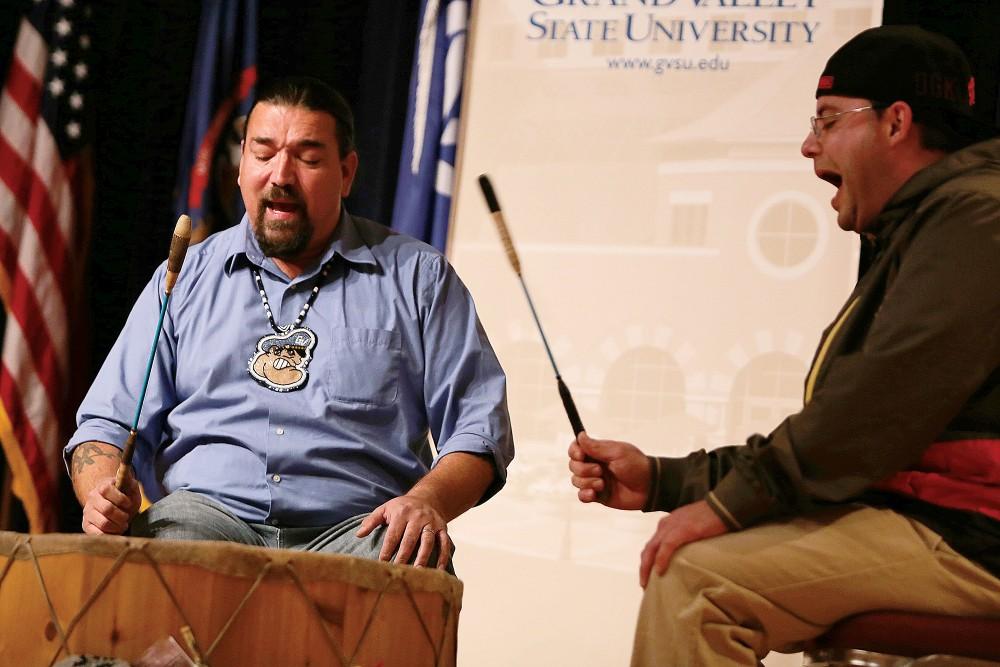“We’re still here”

Nov 20, 2013
Students and community members gathered at Grand Valley State University’s Loosemoore Auditorium on Tuesday to watch a documentary and discuss with a panel how Native American culture and tradition are still thriving today.
The Office of Multicultural Affairs sponsored the event as part of Native American Heritage Month. The film, called “Our Fires Still Burn: The Native American Experience,” is a recently completed documentary that includes interviews with many Native people, who emphasize the importance of keeping their culture alive.
Audrey Geyer, the film’s executive producer and director, is also the founder of Visions, a nonprofit video production company in Detroit. Geyer said her goal in creating the film was “to understand more about Native American culture” and show where they are today.
“It’s an important minority population that is so rarely understood or heard,” she said. “I was hoping people would not only learn about Native history and culture but would also learn about their own spirituality or identity.”
The film highlights the history of the Native peoples in America, calling mainstream society’s treatment of them the “American Holocaust.” Many Native Americans have lost their identities through the loss of their culture, especially their language and traditions.
One example the film showed was boarding schools. Native American children were often forcibly removed from their homes and taken to these schools, where they would be taught how to blend in with white America. The goal was to “educate the Indian out of them.” In this way, the children began to lose their language and culture, essentially stripping them of their Native identities.
Despite the history of violence and oppression, “we’re still here,” said one Native man in the film. The film highlighted the need to educate future generations of Natives and non-Natives alike in order to raise awareness about Native American culture and its significance. There is also a need to rise above misconceptions and cultural stereotypes, such as the idea that all Native Americans are wealthy because of casinos. These false beliefs should be combated by taking pride in cultural heritage and relearning traditional dances, songs, ceremonies and languages, which are essential to a people’s survival.
“Our Fires Still Burn” also addressed the social problems among the Native American people, especially on reservations. One interviewee said Native Americans have high numbers of teen suicide, pregnancy and imprisonment. He attributed this to the “disconnect with our culture.”
Levi Rickert, editor-in-chief for Native News Network, was the producer of “Our Fires Still Burn.” He said he was “proud to be part of it” because of what the film does for Native people like himself.
“It is so important for us to tell our stories because we know what the other guy has done to us,” Rickert said. “We have some really strong messages that need to be out there.”
He also stressed the importance of teaching people about Native American history, especially because the American education system is “still failing to accurately teach what Natives are all about.”
Rickert added that the media is not much better. Often, major news outlets will not report on happenings in the Native community.
In addition to keeping their culture alive, Native Americans can combat problems through telling their stories and using media outlets like the Native News Network, which is a website dedicated to preserving Native language and culture.
“The portrayal of Indians in the media is really dismal,” Rickert said. “It’s important that Native media puts the pressure on.”
Geyer agreed that people need to do their own research and look at the world with a critical eye.
“We all have to think about what we’re reading or watching,” she said. “Don’t let it be spoon-fed to us. Don’t take things at face-value. We need to evaluate and question things more.”
For more information about the film, visit http://www.ourfiresstillburn.com/.

























